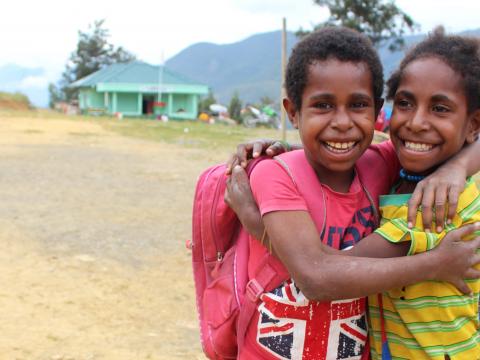Learning from stones and sweet potato

For Papuan, stones and sweet potatoes are two inseparable objects.
Stones and sweet potatoes are part of Bakar Batu (rock burning), an age-old ritual in Papuan tribes to celebrate several big occasions such as funeral, harvest, or conflict resolution. It is also a traditional cooking method where sweet potatoes and meat (chicken or pork) are cooked with the heat of hot stones placed in a ground hole covered by grass.
As a cultural heritage, rock burning contains many values and life lessons for Papuans.
One of the important values is reconciliation. When the stones, leaves, sweet potatoes, and meat are cooked, there is peace and reconciliation in it. Based on tribal wars that occasionally happened in the past, almost all tribes in Papua agree that rock burning is a symbol of local peace.
However, the rock burning ritual is threatened by globalization that slowly comes to almost all areas in Papua.
World Vision Indonesia in Papua through Papua Peace Education (PAPEDA) project facilitates teachers to bring cultural heritages such as rock burning as an alternative tool for students to learn.
In the middle of March 2015, the atmosphere of the primary school in Lanny Jaya grew festive! Children from first to sixth grade gathered in the schoolyard.
The students help their teacher to prepare the hole in the ground for rock burning ritual.
Teachers asked the students to learn outside of the class to celebrate the rock burning ritual. It was the first time for students to celebrate and learn from the ritual together.
Some girls had brought sweet potatoes and vegetables using a noken, a traditional woven bag, while the boys carried firewood.
“I've brought sweet potatoes, Miss!" a first-grader shouts to the teacher. The boy ran fast through the yard and placed them near the pile.
On the other side, Yan, 14, the biggest boy among all of the students, enthusiastically split log by log into small firewood. He said that he usually split logs at home to help his parents.
Another group of boys worked together to carry dry grasses toward the cooking hole in the ground. Some others cleaned up the area and helped their teacher to put dry grasses over the hole.
The stones were put inside the hole. It took many hours to ‘cook’ the stones.
“We need to be patient waiting for the stones to cook. But I see that my students are patient. I can teach them how to be patient and how to respect the process through rock burning,” said Lina, 42, a third grade teacher.
After it was hot enough, the students and teachers moved the hot stones over the grass. Teachers and students worked together to put grasses and stones over the sweet potatoes. Spicy chicken meat was placed on the top before more hot stones and grasses. The pile was covered with big tarpaulin to keep the heat inside.
While waiting for the food to cook, teachers and students spent quality time together.
Teacher Lina, for example, taught students about math by asking them to remember about how many stones that each of them has lifted from one place to another. Not only math, teachers asked students about moral lessons from like cooperation, collaboration, and respect for each other.
Finally! Everyone gets to eat together after learning together throughout the day.
